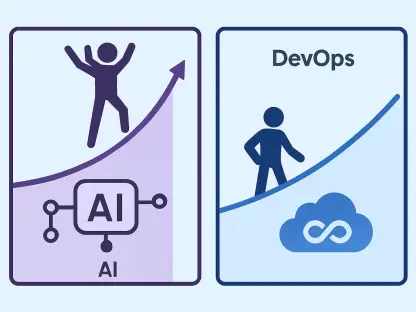Meet Vijay Raina, a renowned expert in enterprise SaaS technology and software architecture, here to explore the exciting intersection of AI and Java development. As AI transforms our approach to building intelligent applications, this conversation delves into integrating AI with Java, covering tools, frameworks, and essential setups. The exploration promises insights into deep learning innovations, practical AI implementations, and the seamless scalability AI frameworks offer developers.
What are some potential benefits of integrating AI into Java applications?
AI integration into Java applications can dramatically enhance their capabilities. From improving user interactions with natural language processing to automating image recognition tasks, AI enables applications to perform functions that were previously unattainable. AI-infused apps can offer more intuitive user experiences, manage large-scale data efficiently, and provide personalized services, thereby adding great value to both developers and end-users.
Can you explain the difference between machine learning and deep learning?
Machine learning (ML) is a broad field of AI focused on teaching computers to learn from data and improve their performance over time. Deep learning, a subset of ML, employs neural networks with many layers, enabling the modeling of intricate patterns in data. While ML algorithms can address a wide range of tasks, deep learning excels at handling complex processes like image and language recognition by simulating the way human brains work.
What are some AI frameworks and APIs available for Java developers?
Java developers have access to several powerful AI frameworks and APIs, including Deeplearning4j, TensorFlow, and the OpenAI API. Deeplearning4j offers seamless deep learning integration within Java applications, making it a valuable resource. TensorFlow’s Java API provides versatile solutions for machine learning and deep learning tasks, allowing for efficient model building and deployment. The OpenAI API specializes in advanced language tasks, facilitating smart language feature implementation through prompt engineering.
Why might the tutorial focus specifically on the TensorFlow Java API and OpenAI API?
The tutorial zeroes in on these APIs due to their robust feature sets, well-supported documentation, and user-friendly design. TensorFlow’s versatility in handling varied machine learning duties and OpenAI’s prowess in language tasks make them ideal choices for Java-based AI initiatives. Both APIs provide comprehensive tools that simplify integrating advanced AI functionalities into applications.
What are the essential steps for setting up an environment to use TensorFlow and OpenAI in Java?
Setting up involves ensuring that your environment is primed for both TensorFlow and OpenAI integration. Java version 8 or newer is essential, along with additional installations like libtensorflow_jni for TensorFlow compatibility. Obtaining an API key for OpenAI is straightforward; it can be secured from their official website, facilitating access to its extensive language processing features.
What practical AI implementations in Java were highlighted in the tutorial?
The tutorial showcased practical implementations such as image classification using TensorFlow, natural language processing with the OpenAI API, sentiment analysis with TensorFlow, and chatbot construction using OpenAI. These examples display tangible applications where AI enhances user experience and operational efficiency in Java applications.
How does image classification with TensorFlow work, and why is deep learning effective for this task?
Image classification involves leveraging pre-trained models in TensorFlow to categorize images effectively. Deep learning is particularly suited for this task due to its ability to decipher complex patterns within visual data. Neural networks in deep learning can process images similar to human visual interpretation, making them powerful tools for accurate and rapid classification.
Can you describe how the OpenAI API is used for natural language processing and generating human-like responses?
The OpenAI API facilitates natural language processing by using advanced models to comprehend and generate human-like responses. Developers control response variability by adjusting “temperature” — lower values yield more deterministic responses, while higher values allow for creative outputs. This flexibility enables applications to tailor interactions to user expectations and context requirements.
How is sentiment analysis performed using TensorFlow in Java, and how is the sentiment score interpreted?
Sentiment analysis with TensorFlow involves using pre-trained models to evaluate text sentiment, producing scores ranging from 0 (fully negative) to 1 (fully positive). Intermediate scores indicate nuanced sentiment levels, helping applications gauge customer mood and refine interactions accordingly.
What is the process of building a chatbot using OpenAI as described in the tutorial?
Building a chatbot with OpenAI is centered around utilizing its language models to generate dynamic conversation. By setting specific prompts and parameters, developers craft chatbots capable of understanding and responding intelligently, providing users with interactive and engaging experiences.
How do the tools like TensorFlow and OpenAI API help in integrating AI into Java applications?
These tools simplify complex AI integration tasks, allowing Java applications to leverage AI’s full potential effortlessly. TensorFlow supports diverse ML and DL operations, while OpenAI drives advanced language processing capabilities. Together, they empower developers to incorporate cutting-edge AI features without compromising scalability or performance.
Why are frameworks like TensorFlow and OpenAI considered flexible and scalable?
TensorFlow and OpenAI are celebrated for their adaptability and scalability. They offer modular architectures that handle varying workloads efficiently. Such flexibility ensures smooth scalability, catering to applications ranging from simple prototypes to large-scale, production-grade systems and accommodating evolving needs without major overhauls.
What are some suggestions given for experimenting with AI models or adjusting parameters within your applications?
The tutorial encourages developers to experiment with AI models and parameters like temperature settings in OpenAI or classification techniques in TensorFlow. Adjustments should be made strategically to suit specific application goals or user requirements, enhancing functionality and user satisfaction.
How can further information be obtained if developers have specific needs beyond the tutorial?
For developers seeking advanced insights, exploring extensive documentation—especially TensorFlow Java documentation and OpenAI resources—would be advantageous. These sources provide detailed guidance and additional examples, ensuring developers can address unique needs and challenges during application development.
What advice is given for next steps to feel the power of AI in your applications?
Developers are urged to integrate pre-trained models into their apps to quickly leverage AI’s capabilities. Experimentation and feedback collection are key to refining and enhancing AI implementations, ensuring they effectively meet user demands and application goals.









